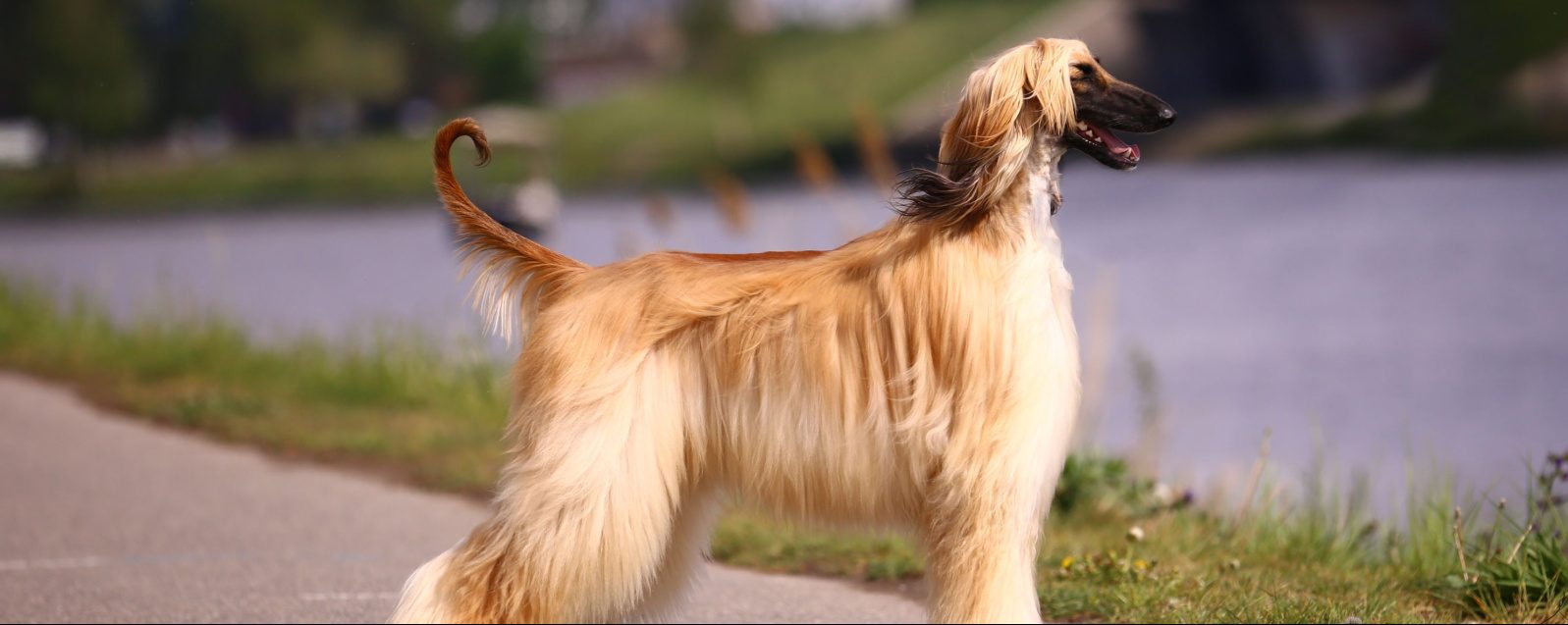-
Activity Level:
high
-
Shedding Level:
moderate
-
Grooming Level:
high
-
Trainability:
moderate
-
Good for Novice Owners:
low
-
Adaptability:
moderate
-
Kid/Pet Friendly:
sometimes
-
Prey Drive:
high
-
Watchdog:
aware
- Average Size: Medium
- Average Lifespan: 12-18 Years
- Registered?: aca, akc, other
Afghan Hound Dog Breed Information
Overview
Temperament
Adaptability
Health
Owner Experience
Grooming
Activity Level
Size
Life Span
Did You Know?
Afghan Hounds are a popular show dog breed that are well-recognized for their long, narrow snouts, thick and silky coats, elegant and dignified appearances, and curled tails. Despite looking like a pampered aristocrat, these dogs are actually quite sturdy and athletic.
They originated in remote mountainous locales across the vast area that is now Afghanistan, India, and Pakistan and are considered an ancient dog breed. Although we don’t know exactly when the breed began, we do know that the Afghan Hound predates written history, and can be traced to at least a few thousand years before it. They could potentially be the oldest of the purebred dog breeds.
These dogs were bred to fast sighthounds to assist in hunts in Asia’s mountain regions. Their long, thick, silky coats were developed specifically to help keep these dogs warm and protected in harsh mountain climates without weighing or slowing them down. They also have huge paw pads that helped them gain traction and absorb shock as they ran along rough terrain.
Not only were they valued hunting companions, but Afghan Hounds were also noble companions among aristocrats, tribal chieftains, and royals in these areas; so much so, that they became status symbols for royalty and nobility. Although these dogs were well-known in the East, they remained relatively unknown in the West until the late 1800s.
Officers of the British Empire at the time are credited with bringing the dog back with them and introducing the breed to Europe where they quickly gained popularity. Afghan Hounds became the preferred dog breed among the British gentry by the early 1900s. The AKC recognized the Afghan Hound in 1926 as a member of the Hound Group. It wouldn’t be until the early 1930s that the Afghan Hound would start to catch on and gain popularity in the United States.
Afghan Hounds may have a dignified appearance and may seem independent and aloof. To strangers and people they aren’t familiar with, they maintain that. For their favorite humans and the people they bond with, Afghan Hounds are very loyal and affectionate dogs. They even get a little silly and playful sometimes when they are comfortable and with their favorite people.
Well-socialized, they do get along well with children and other dogs, but can be sensitive and prefer quieter, calmer environments. Aloof and wary of strangers, they can warm up once introduced provided they are well-socialized, but may not seek out affection from people until they are more familiar.
Their high prey drive can mean they are not the best fit for homes with other smaller pets. They could do well with smaller animals that they have been raised and socialized with, but will still retain their urge to chase for animals outside of the family.
Afghan Hounds are moderately to highly adaptable dogs. Although they have a lot of energy and are best suited to homes with fenced yards where they can run, they can adapt to apartments as long as they get enough daily exercise, attention, and mental stimulation. They are excellent jumpers and also have a high prey drive and urge to chase, so they should only be let off-leash in secure areas with high fences.
Bred to hunt and traverse harsh mountain terrain and climates, these dogs do relatively well in the cold. As with any dog breed, they are sensitive to heat. Although they can be okay with some alone time, they still prefer to be near their favorite humans and bond closely with them. So, they do not like to be left alone for long periods of time.
Potential health concerns to be aware of in Afghan Hounds can include hip dysplasia, hypothyroidism, cataracts, progressive retinal atrophy, diabetes, allergies, and skin tumors. Good breeding practices and the health of the parents make a big difference in the health of Afghan Hound puppies.
Reputable breeders will screen their dogs to ensure they are not passing preventable issues to puppies, so make sure you ask about the health and genetic history of both parents. You can also ask about any health tests for clearances that have been done. The national breed club recommends a hip evaluation, ophthalmologist evaluation, and thyroid evaluation at a minimum.
As a sighthound, Afghan Hounds are built to be lithe, limber, and fast. This also means they naturally tend to be thinner and have lower stores of body fat than stockier breeds. This can make them sensitive to anesthesia and you will want to make sure you are choosing the right veterinarian who has experience with sighthounds, especially for any future surgical needs.
Afghan Hounds are also deep-chested dogs, which means they are at a higher risk of bloat. Bloat in dogs can be dangerous and quickly becomes life-threatening if gastric torsion occurs (i.e. the stomach flips), so it’s important to know how to reduce the risk and the warning signs that mean it’s time to get to the emergency vet.
Although they are highly intelligent dogs that pick up on things quickly, Afghan Hounds tend to be aloof and independent, at least until they bond with you. Once an Afghan Hound has bonded with you, they are affectionate, loyal, eager to please, and obedient.
This initial independence and determination, paired with this breed’s urge to chase and high energy, can be difficult for a first-time dog owner. They are generally recommended for more experienced dog owners. Novice dog owners can be successful with Afghan Hounds, but puppy training classes or a professional dog trainer are recommended.
Afghan Hound puppies do not require much coat maintenance as they have short, fuzzy coats and “monkey whiskers”, which refers to some facial hair that they will grow into. But, although Afghan Hounds do not shed much, they also do not have low-maintenance coats.
Once they start growing the iconic long, silky Afghan coat, they will need daily brushing to keep their hair from tangling and matting. These dogs also require regular bathing and professional grooming throughout the year.
In addition to coat care, you also need to take care of your Afghan Hound’s nails, ears, and teeth. Nail trims once or twice a month are usually enough to keep nails from growing too long. Ear checks weekly and carefully cleaning your dog’s ears when needed can help prevent ear infections. Daily dental care, like brushing teeth or using an enzyme toothpaste, along with cleanings at the vet when needed can help prevent painful dental diseases later in life.
These dogs were built to run and they have the energy to match. Although they can sit in a moderate activity range, they are usually high-energy dogs. Daily walks plus playtime, time to run, and other activities are usually enough to keep these dogs happy, but they will likely be up for more activity if you are.
Afghan Hounds are also athletic dogs, so once puppies finish growing and their joints are done developing, you can do higher-impact activities with them. They tend to like to run and were bred for it, which makes them one of the dog breeds that make good running partners. They might also enjoy hiking with you or competing in dog sports.
Fully-grown Afghan Hounds usually stand 25-27 inches tall and weigh 50-60 pounds.
Afghan Hounds generally live for 12-18 years on average.
Zeppo Marx, the youngest of the Marx brothers, is credited with importing an important breeding pair of Afghan Hounds from England. Although they weren’t the first Afghan Hounds in the U.S., this breeding pair is considered important to the breed’s modern history and its popularity in the United States.
Also, one of the facts about Afghan Hounds is that the first cloned dog in history was an Afghan Hound named Snuppy in 2005.






